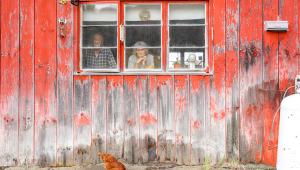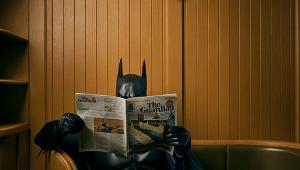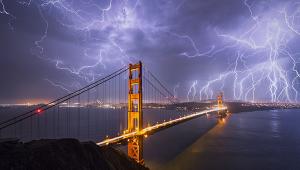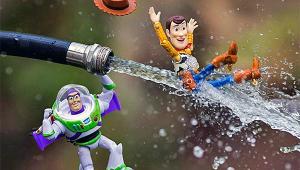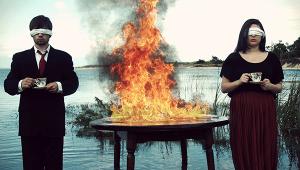Thanks for such a question.. "How did you start out learning photography?"
I just find out some special on Darkroom manipulation.. This is great.
Master Photographer Interview: Jerry Uelsmann (Page 2)
But my initial approach is very non-intellectual. I just can't emphasize that enough. Today there is a lot of conceptually based art that begins with a particular theory and then the individual makes the images to fit. It's like an assignment, all planned and then they just follow through and do the work. My approach is a lot less premeditated.
|
Untitled - 1986
|
 |
SB: More of a spontaneous response to the world?
JU: Yes, and as a result I think my work has been very challenging for some people to deal with. A lot of it is psychologically and emotionally based. That's harder to write about than art that is theory based, as much contemporary art and post-modernism is. Plus, over the course of the year I make some images that are very playful, others that are very dark. Some of them no one would want to have on their wall. But I'm the first audience, so I'm making them for my own satisfaction.
SB: Your work has been analyzed in terms of Carl Jung's theory of the Collective Unconsciousness and its concept of Archetype. Do you see your work that way?
JU: Well, yes. And, in today's art world French philosopher Jacques Derrida's theory of multiple meanings is also having an influence. There's not a common syntax in a lot of visual material so people respond to it differently. When you have subjects that are really open-ended, like a floating rock or a tree or whatever, that causes the consciousness of the viewer to come up with their own way of connecting with that image. It's the audience that completes the cycle.
This, to me, is the wonderful part of photography and all the arts. There is a kind of an emotional impact that can be felt when you see certain images. It goes beyond communication, as we know it. Once you have seen Weston's photograph of the pepper, you can't pass them in the grocery store without thinking about these things as aesthetic objects. His vision took a common vegetable to a new level. That's the aspect of art that I like.
|
Untitled - 1996
|
 |
SB: Your work can be seen as very complex, or quite simple.
JU: The joke that I tell when I lecture to art students is, "What happens when you cross a post-modernist with a used car salesman?" The answer is, you get an offer you can't understand. That always draws a big laugh from the college students because they're required to read stuff that is so complex that much of it doesn't make any sense, at least not to me.
SB: You've spoken about risk taking and even how self-doubt can be part of the creative process.
JU: Well, I do think, particularly the way I work, the better images occur when you're moving to the fringes of your own understanding. That's where self-doubt and risk taking are likely to occur. It's when you trust what's happening at a non-intellectual, non-conscious level that you can produce work that later resonates, often in a way that you can't articulate a response to. So much of what we consider knowledge involves being able to state something in words. But there is another level at which things impact us in a visual way that we really can't articulate a response to.
SB: But nonetheless, we have a visceral or an internal connection to some of the elements.
JU: Right. That's important. I've enjoyed teaching photography to all kinds of students from beginning to graduate level, and I've always felt that walking around with their cameras gave them all kinds of insights that were as important as spending hours in the library.
|
Untitled - 1992
|
 |
SB: You have for many years been the acknowledged master of multiple printing and the art of physically collaged images in the darkroom. I'd like to pull a quote out of your new book, Other Realities, which I think is truly eloquent. "I am sympathetic to the current digital revolution and excited by the visual options created by the computer. However, I feel my creative process remains intrinsically linked to the alchemy of the darkroom." We've talked mostly about the aesthetic of your work. Perhaps we can talk a bit about your technique and the digital revolution that is going on in photography.
JU: It's interesting how many people assume it's a competition. Actually, Photoshop has generated a much broader audience for my work. When I started people questioned if my work was really even photography, it was so different than the Group f64 approach. Now there are new audiences for my work. And young people who are learning digital skills discover that the real challenge is coming up with an image that resonates, first of all, with your self and hopefully, with an audience. They can learn all these new techniques and think that they're easier to use, but creating great images isn't about the tools.
SB: Your wife, Maggie Taylor, is a major digital artist.
JU: Yes, and she's having a huge success. She's a wonderful image-maker. We both actively engage in the image-making process, and work a seven-day week. It's not uncommon for her to be at the computer and me to be in the darkroom many evenings.
I see the incredible options that Photoshop provides. But the bottom line is the technique has to fit with ideas and images. I fell in love with the alchemy of the photographic process and to this day, watching that print come up in the developer is magic for me. I still find it a wonderful, challenging experience. It's also a kind of personal therapy for me just to engage in that process. If travel and other work keep me out of the darkroom a couple of weeks, I'm not a nice person to be with.
Of course, in order to make art, the frustration of not working has to be greater than the frustration of working. I try to push images as far as I can. Sometimes I go too far, then as time passes, I think, "That was stupid or overkill" or whatever. But you have to go to those places. You can't just say, "We have an hour to talk on the phone, let's only be profound." You start wherever you can and then you work at it.
For me, every year I produce at least 100 different images and at the end of the year, I try to sit back and look at them and find 10 that I like. Many years, it's hard to find those 10.
|
Untitled - 1978
|
 |
SB: You're making judgments when you're looking at those 100 images that you've created; do you solicit feedback from others as well? Or is it mostly an internal dialog with yourself?
JU: Actually, that's a good question. I have some very wonderful friends in academia and the arts. For years I'd have these close friends over to look at the prints and I'd ask, "If you could have 10 of these prints, which ones would you want?" I didn't want a heavy intellectual analysis, just personal responses to the images. The crazy thing was that in most cases, there was not a lot of agreement. Obviously, there would be some overlap, but it's a big world out there and people do bring their own sort of aesthetic to bear. But I'm the one who ultimately has to decide when I send things off to finally be in an exhibit or be published.
It's not easy. Sometimes I have a kind of cognitive dissonance. There are images that I've worked on for so long and have fussed over so much that I think they just have to be good. The amount of energy I put into creating them becomes a factor for me. Those are ones that, as time passes, I might later reject. At other times, an image may just involve two negatives and a simple blend, but people say, "Hey, this is a great one." I'm thinking, "Well, that was a little too easy." But that's really not the case.
SB: How much time and experimentation takes place in the darkroom?
JU: Once I'm set up I need at least a six-hour block and preferably an 8-10 hour block to do what I do. Computer people have this advantage over the darkroom people by far.
SB: Do you think it is easier to create images using a computer?
JU: It's equally hard and labor intesive to create an image on the copmuter as it is in a darkroom. Believe me.
SB: You are still working, producing new images all the time.
JU: To me, it's such a rewarding experience to be able to produce personal imagery and have this kind of visual myth emerge over a period of time, making images that can evoke a different perception of our world. We are unique in that we can invent these realities.
SB: You taught for 38 years; how did you challenge students to be the most creative and effective photographers they could be?
JU: The best teachers answer questions with more interesting questions. That really sums it up. This is what I've learned after years of teaching--education is essentially a question-raising business.
To see more of Jerry's work, visit www.uelsmann.net Larry Berman and Chris Maher are photographers, writers, and web designers, specializing in image-intensive photography sites. For more information, visit their websites at: www.BermanGraphics.com and www.InfraredDreams.com.
- Log in or register to post comments




